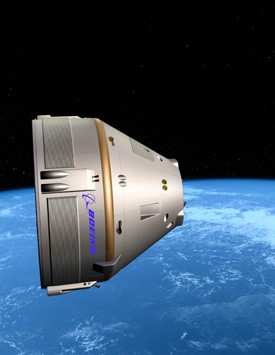Tue, Apr 24, 2012
Initial Commercial Space Transportation Flight Ops To Be Coordinated With Johnson Space Center
An agreement has been signed between NASA's Mission Operations Directorate (MOD) at Johnson Space Center and Boeing to collaborate on mission planning, training and flight operations for the company’s Commercial Space Transportation (CST)-100 spacecraft. Under the new arrangement, which Boeing negotiated under its current Phase 2 NASA Space Act Agreement for Commercial Crew Development, Boeing will begin discussions with the MOD on integrating launch operations and the company's own mission control facility at Kennedy Space Center, FL, with training and real-time operations at Johnson Space Center in Houston.

"Adding MOD to our team leverages NASA's experience in crewed space operations to ensure mission success for our CST-100 spacecraft," said Chris Ferguson, director of Crew and Mission Operations for the Boeing Commercial Crew Program. "As we continue to mature our spacecraft design, MOD technical support will ensure the CST-100 is built with the operators in mind."
Later this year, Boeing intends to enter into a larger agreement with the MOD to provide end-to-end flight operations from the command and control facility in the Mission Control Center at Johnson Space Center, the site where NASA managed the Apollo missions and all 135 flights of the space shuttle. "Colocating initial CST-100 flight operations with the International Space Station flight control facility in the Mission Control Center will facilitate a seamless transition to regularly scheduled CST-100 operations with the space station," Ferguson said. "Working with MOD on Boeing's mission operations also will help NASA retain key proficiencies for future human spaceflight operations."
The CST-100 is a reusable capsule-shaped spacecraft based on flight-proven subsystems and mature technologies. The system can transport up to seven people, or a combination of people and cargo. Boeing has designed the spacecraft to be compatible with a variety of expendable rockets to enable competition and reduce cost over the program life cycle. The company has selected United Launch Alliance's Atlas V launch vehicle for initial test flights that will begin as early as 2015.
Boeing is continuing to develop the system design at its Houston and Huntington Beach, Calif., sites and is making preparations to manufacture, assemble and test the CST-100 spacecraft in the former Orbiter Processing Facility-3 at Kennedy Space Center. (Image provided by Boeing)
More News
DETRESFA (Distress Phrase) The code word used to designate an emergency phase wherein there is reasonable certainty that an aircraft and its occupants are threatened by grave and i>[...]
Aero Linx: The International Association of Missionary Aviation (IAMA) The International Association of Missionary Aviation (IAMA) is comprised of Mission organizations, flight sch>[...]
Also: EP Systems' Battery, Boeing SAF, Repeat TBM 960 Order, Japan Coast Guard H225 Buy Despite nearly 100 complaints totaling millions of dollars of potential fraud, combined with>[...]
Also: Viasat-uAvionix, UL94 Fuel Investigation, AF Materiel Command, NTSB Safety Alert Norges Luftsportforbund chose Aura Aero's little 2-seater in electric trim for their next gli>[...]
Also: Moya Delivery Drone, USMC Drone Pilot, Inversion RAY Reentry Vehicle, RapidFlight UAVOS has recently achieved a significant milestone in public safety and emergency services >[...]
 ANN's Daily Aero-Term (04.26.24): DETRESFA (Distress Phrase)
ANN's Daily Aero-Term (04.26.24): DETRESFA (Distress Phrase) ANN's Daily Aero-Linx (04.26.24)
ANN's Daily Aero-Linx (04.26.24) Airborne 04.22.24: Rotor X Worsens, Airport Fees 4 FNB?, USMC Drone Pilot
Airborne 04.22.24: Rotor X Worsens, Airport Fees 4 FNB?, USMC Drone Pilot Airborne 04.24.24: INTEGRAL E, Elixir USA, M700 RVSM
Airborne 04.24.24: INTEGRAL E, Elixir USA, M700 RVSM Airborne-NextGen 04.23.24: UAVOS UVH 170, magni650 Engine, World eVTOL Directory
Airborne-NextGen 04.23.24: UAVOS UVH 170, magni650 Engine, World eVTOL Directory



